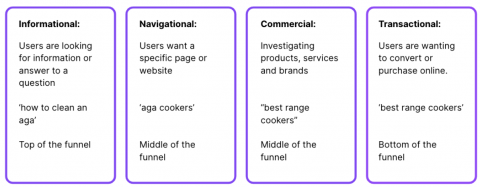According to Semrush, 70 million blog posts are published every month, which equates to, on average, 2 million every day – that’s a lot of content. So, how do we get noticed in an oversaturated market? How do we create content that our customers will still find valuable?
There’s a brilliant quote on Content Design by Sarah Richards that sums up the way we should all think about content: she says, “Not more content, smarter content”.
It sounds obvious but, unfortunately, many marketers still underestimate the importance of a carefully planned and well-documented content strategy. Many still opt for quantity over quality.
That’s an approach that is no longer sustainable and rarely brings results.
Whether you’re currently publishing shallow content without a plan or you already have a content strategy that you wish to improve, this article will show you how to create a winning content plan.
But before moving onto our step-by-step advice, let’s first define what a content strategy is and the reasons why you should incorporate one into your marketing plan, no matter what industry you’re in.
As part of the Organic team here at Hallam, developing a content strategy for our clients is part of our bread and butter. With more and more businesses realising the importance of a content strategy and investing in them, how can you take steps to make sure your content stands out from the rest?
Does content strategy apply to every industry?
Absolutely. If you have customers, you have content opportunities. It’s really that simple.
If you are in what is considered a niche industry, don’t make the mistake of thinking that creating great content isn’t something that applies to you.
Think back to the past week – how many mundane queries did you type into Google?
I’ll go first – “how to get marker stains off school uniform” and “tyre pressure light keeps coming on” spring to mind. Hardly the most exciting topics, yet the articles I read were invaluable to me at the time.
Focus your attention on reaching people that need you and you can’t go wrong.
What is a content strategy?
A content strategy defines how you use content to satisfy your users’ needs and meet your business goals. It replaces the “throwing it out there and hoping it sticks” kind of approach and, instead, it allows you to provide the right content, to the right audience, with clear objectives in mind.
A content curation strategy isn’t something you do once and leave to gather dust – it should be constantly evolving to ensure you are keeping up with your customers needs, wants and demands at every stage of the user funnel.
It’s a human-first approach and, as we know, humans are very rarely static. You need to evolve as your customers evolve so that you can use your content strategy to help reach your business objectives, whether it be to drive engagement, traffic, leads or sales.
Don’t confuse your content strategy with your content marketing strategy either. A content strategy is the why and how you are going to create content on your site, while content marketing offering encompasses this and more, including an amplification plan.
Our tried-and-trusted method breaks up this process into three phases:
- Discovery – the aim of the discovery phase is to gather as much information as possible ahead of the content execution. This includes setting goals and understanding your audience, as well as checking out the competition and auditing the content that you already have.
- Execution – this is the “get stuff done” phase. Taking into account the information collected during the discovery phase, this is when you create an editorial content calendar and start generating your content. Content amplification, i.e. getting it in front of your target audience, is also part of this phase.
- Analysis and fine-tuning – this is when you analyse your content effectiveness and, if necessary, make adjustments to your original plan to make it even more powerful.
How to develop a content strategy
Every digital content strategy needs to begin with a discovery phase which should include the following actions:
Define your goals
Without well-defined objectives, content is just noise. Therefore a content strategy should always start with defining what you want to accomplish.
Businesses goals will vary greatly but a few top-level examples include:
Sales and revenue
Revenue-driving content is about convincing prospective customers that you’re the best brand to work with, your products and services are right for them, and your people are a good fit for what they’re building.
Lead generation
Ebooks, guides, email subscriptions, white papers, templates and exclusive events – there are many different ways to use content to generate leads. What they all have in common is that they are behind a “wall”. They’re gated pieces of content.
This allows you to collect data about your customers, such as email addresses. Just make sure what you’re asking for isn’t too intrusive. For example, we usually advise not to ask for phone numbers unless you absolutely need to.
Experiment with different formats and observe what resonates with your customers the most.
Brand awareness
Rather than simply selling your products and services, branded content focuses on your values as a business and what makes you stand out from the competition.
Create content that tells potential customers what you believe in and what your brand stands for. Why should customers choose you over your competitors?
Thought leadership
Closely related to branded content, thought leadership is about establishing your brand as an authority in your niche. Should this be your goal, your content will focus on showing that you have a great understanding of the market and your customers.
You will put forward original insights and unique expertise. Bring something new to the conversation, instead of simply echoing what your competitors or other thought leaders have said.
Customer education
Customer education content provides relevant information to the consumer about a product or service. If this is your goal, your content will still influence sales or leads but this will be done indirectly, by teaching people there is a solution to their problems.
You might have noticed that traffic didn’t make it into the list. This is because when content is well-researched, well-distributed and well-optimised from an SEO perspective, an increase in traffic will happen automatically.
Define your audience
Customer or buyer persona research is vital if you want your strategy to succeed. Boiled down to the basics, the questions you want to focus on include:
- Who do you want to reach?
- What does your audience care about?
- What are their pain points?
- How and where do they like to consume information?
How you capture this information depends on your organisation’s setup and resources. If available, use existing customer research and personas (as long as they’re still relevant).
Speak to the people who are closest to your customers (i.e. call centre and customer-facing staff), review what your audience says about your brand on social media, take a look at the reviews they leave or run a survey.
Keyword research will help greatly at this stage too as it will give you visibility of your customers’ most searched for products, problems and questions.
Audit your content
Conducting a content audit will help you with your content strategy by saving you time. There may be some content pieces that could do with tweaking or updating rather than a complete rewrite. Or multiple small pages that can be combined into a comprehensive guide.
If you also know what’s working (and what isn’t!), you can then use this information to inform your content strategy and ensure that anything you do moving forwards is backed up by data.
Run your analysis and split your content into four groups:
- Keep: the content performs well, is still relevant and fits into your overall objectives. No changes are necessary.
- Update: the content still offers value, but there are specific parts that are redundant and therefore need revising and updating.
- Consolidate: use this action when you have multiple pages covering the same topics. Combine these pages into a comprehensive resource.
- Redirect: the content is redundant or receiving such little traffic it’s not worth keeping. Here, you’ll want to take users to another page instead.
Analyse your competitors
For long term content creation to matter, you must have a good understanding of your industry and its key players and conduct an in-depth competitor analysis.
Check out what your competitors are doing. What are they doing well? What content formats are they using? What sort of engagement is their content driving? What are your strengths?
From an SEO perspective, you can use tools such as Semrush or Ahrefs to look at your competitors’ top-performing content and work on a keyword gap analysis. Manual analysis is extremely valuable too.
It’s also worth remembering at this stage that your perceived competitors might differ from who you compete within the search engines. You might also have different competitors depending on what product/service you’re focusing on. Make sure you know who you’re up against.
Conduct keyword research
Keyword research is one of the most important steps to take before you jump straight into a content strategy. You need to ensure the content you are creating later down the line is led by search terms you know people are searching for in order for it to rank effectively.
Understand search intent
When thinking about search intent, it’s also important to consider the user funnel. There are a number of different ways people search which shows what action they want to follow up with.
- Awareness – this is when people are searching informational terms and looking to educate themselves around a specific topic. This could be a term which includes ‘how to…’, for example.
- Consideration – this is when your specific audience is looking for more information about a product or service. They are not ready to buy yet but might be comparing companies. They have a navigational or commercial search intent.
- Conversion – these keywords will clearly show the users intent as they will most likely start with ‘buy’, for example and will be looking to access your product or service pages to go through to purchase/sign up. They have a transactional search intent.
Consider content formats
By this stage, you should have established your goals, who you are talking to, their needs and what your competitors’ strengths and weaknesses are.
This is when you really start bringing everything together by matching user needs with your brand’s expertise, products and services.
My favourite way to do this is to use post-its or an online whiteboard app, such as Miro. Jot down what your customers want and brainstorm content ideas that will help you address those needs.
While copy might be the easiest and quickest to create, remember that content refers to a wide range of formats and types of content from video and images, to podcasts and case studies. Choose what’s most appropriate for your customers and to hit your goals.
Once you have an understanding of all this then it will be time to move into the execution phase and create your content plan.
How to create a content strategy and plan
In its most basic form, a content plan lays out what content you plan to post and when. It can include everything from editorial content alone to rich assets, such as video and social media content.
You don’t need any fancy software, an Excel or Google Sheet will suffice, and there is certainly no shortage of content strategy templates available online.
The key benefits of using a well-documented editorial calendar are:
- Enables you to plan ahead and organise your content around key events, dates, and product launches
- Gives you a clear view of what’s coming up so that you can set aside enough time to do all the necessary prep
- Helps you maintain consistency as you’ll easily be able to spot any gaps and fill them accordingly
- Provides visibility across different departments, particularly if you work for a large organisation and there are many people involved
Analysing and fine-tuning your content strategy
Remember the goals you set out in the first step? If you started this process with clear content strategy objectives in mind, then you will find it very easy to select and analyse the right metrics.
Content Key Performance Indicators (KPIs) can generally be grouped into three main categories:
- User behaviour: traffic sources, page views, pages per session, bounce rate, time on page, page scroll depth, dwell time
- Sentiment: comments, shares, likes, mentions
- Conversions: number of leads, conversion rate, ROI
Our recommendation, particularly if you’re only just getting started, is to keep reporting simple and not go overboard with the metrics you track and analyse. Instead, keep your focus on those key elements that will enable you to assess whether you’re getting closer to your set objectives.
As mentioned, your content strategy shouldn’t be something you create once and then leave to gather dust. As your business grows and changes, so will your content strategy so make sure you are revisiting it at least every six months.
It’s key that you turn the data points collected through your measurement and reporting system into actionable tasks and make adjustments where necessary.
If you need help with your content strategy, don’t hesitate to contact us.








